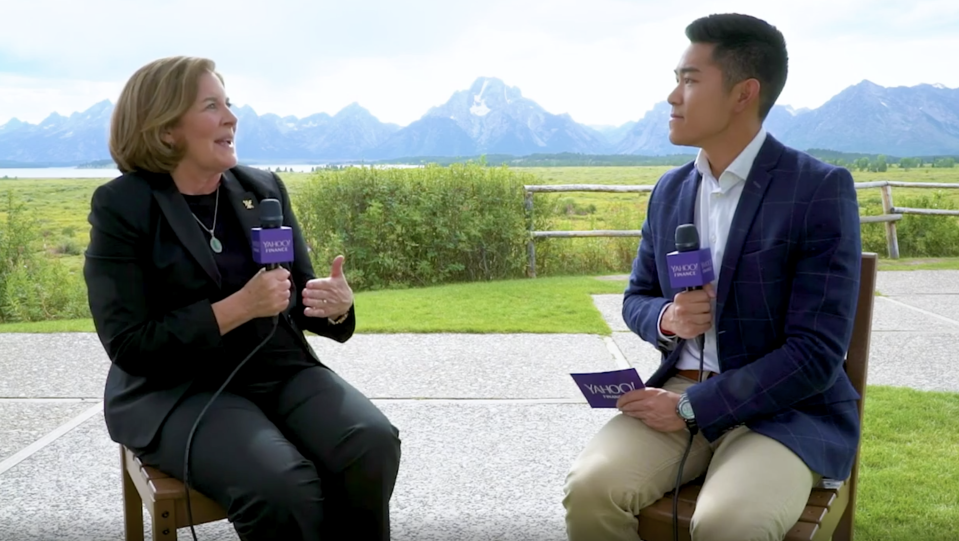Fed's George: It's 'too soon' to judge next move on rates
Federal Reserve Bank of Kansas City President Esther George said she still wants to see more data before the central bank’s next policy-setting meeting on September 18, paying special attention to any impacts of the ongoing trade war.
“There have continued to be concerns, uncertainty around trade,” George told Yahoo Finance on the sidelines of the Kansas City Fed-hosted Jackson Hole conference. “That factors into that. I think it's too soon to judge how the real economy is going to be affected.”
George, a voting member of this year’s Federal Open Market Committee, dissented against the Fed’s July 31 decision to cut interest rates by 25 basis points. In her dissent she said incoming data would have to “point to a weakening economy” before she could support interest rate cuts.
[See Also: Fed's George: Rate cuts 'not likely to resolve' trade uncertainty]
George told Yahoo Finance the data received since the Fed’s last meeting have been “mixed.” In contrast to weakness in business fixed investment, George pointed to estimate-beating retail sales numbers for the month of July.
“I'll be watching the data up until the time that meeting starts,” George said.
One data point that has caught a lot of attention since the last Fed meeting: the inverting yield curve. On August 14, the yield on the 10-year U.S. Treasury dipped below the yield on the 2-year U.S. Treasury for the first time since 2007, just before the financial crisis. This type of “yield curve inversion” has a strong track record of predicting downturns; an inversion has preceded the last seven of seven recessions dating back to 1969.

George said policymakers need to be “careful” reacting to the yield curve, which broadly measures investor sentiment of the economic future in the U.S. Although she acknowledged that inversions are a decent predictor of a recession, she said pressures on U.S. yields may be the result of international pressure.
“Right now, although I'm always careful to say ‘this time is different,’ I think there are some factors when you look at the rest of the world and the weaknesses in some of those economies,” George said. “That could be playing into why we see long-term rates so low.”
Scoring Powell’s communication
Although George did not hint at whether or not she would support cuts in the Fed’s next meeting, she acknowledged concerns over Fed Chairman Jerome Powell’s efforts to communicate its policy to the public.
“Certainly as the policy choices become more difficult, the challenges arise on how to communicate that,” George said. “I think he has done a good job of trying to express how the committee arrives at its decisions.”
Over the last ten months, the Fed shifted from a stance of “gradually” hiking interest rates to being “patient” and then finally to its “insurance” cut on July 31. The speed by which the Fed’s changed its tone has had market participants on high alert, as Fed watchers attempt to figure out what the central bank is going to do next.
Some have warned that the Fed is at risk of “trigger[ing] carnage” by potentially confusing markets.
One difficulty about Fed communication as of the last few weeks has been balancing the now-widened spectrum of policy recommendations among Fed officials. Minutes from the Fed’s July 31 decision to cut rates by 25 basis points showed a huge rift, as two members of the Federal Open Market Committee advocated for 50 basis point cuts but “several” members (including George and Boston Fed President Eric Rosengren) pushed for making no moves on rates at all.
Powell was tasked with explaining the Fed’s decision to go with the middle ground: a 25 basis point “insurance” cut. But markets went for a ride during his press conference announcing the decision; Powell described the move as a “mid-cycle adjustment” before clarifying, “I didn’t say it’s just one [cut] or anything like that.”
George said the Fed is trying to be as “transparent as they can” and applauded Powell for his public-facing efforts on communication, such as having a press conference at every FOMC meeting as opposed to every other meeting (as was custom before Powell’s promotion to Fed chair).
The Fed will be convening in Jackson Hole from August 22 through August 24.
-Jillian Harding and Daryen Ru contributed to this report
Brian Cheung is a reporter covering the banking industry and the intersection of finance and policy for Yahoo Finance. You can follow him on Twitter @bcheungz.
Bonds, yields, and why it matters when the yield curve inverts: Yahoo U
YIELD CURVE INVERTS: Recession indicator flashes red for first time
Congress may have accidentally freed nearly all banks from the Volcker Rule
Read the latest financial and business news from Yahoo Finance


